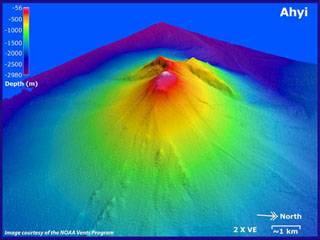Report on Ahyi (United States) — November 1979
Scientific Event Alert Network Bulletin, vol. 4, no. 11 (November 1979)
Managing Editor: David Squires.
Ahyi (United States) Shocks and sulfur upwelling
Please cite this report as:
Global Volcanism Program, 1979. Report on Ahyi (United States) (Squires, D., ed.). Scientific Event Alert Network Bulletin, 4:11. Smithsonian Institution. https://doi.org/10.5479/si.GVP.SEAN197911-284141
Ahyi
United States
20.42°N, 145.03°E; summit elev. -75 m
All times are local (unless otherwise noted)
The crew of the fishing boat Koyo-maru 5 felt a series of shocks beginning at about 1530 on 15 November, followed by the upwelling of water containing sulfur about 15 km SE of Farallon de Pajaros Island at 20.445°N, 145.03°E. Depths in the area of the activity range from 70 to 200 m. The JMSA reports that sea surface discoloration has been observed there in the past.
Since the day before, a larger than normal cloud plume had been observed over Farallon de Pajaros.
Geological Summary. Ahyi seamount is a large conical submarine volcano that rises to within 75 m of the ocean surface ~18 km SE of the island of Farallon de Pajaros in the northern Marianas. Water discoloration has been observed there, and in 1979 the crew of a fishing boat felt shocks over the summit area, followed by upwelling of sulfur-bearing water. On 24-25 April 2001 an explosive eruption was detected seismically by a station on Rangiroa Atoll, Tuamotu Archipelago. The event was well constrained (+/- 15 km) at a location near the southern base of Ahyi. An eruption in April-May 2014 was detected by NOAA divers, hydroacoustic sensors, and seismic stations.
Information Contacts: JMSA, Tokyo; JMA, Tokyo; T. Tiba, National Science Museum, Tokyo.

